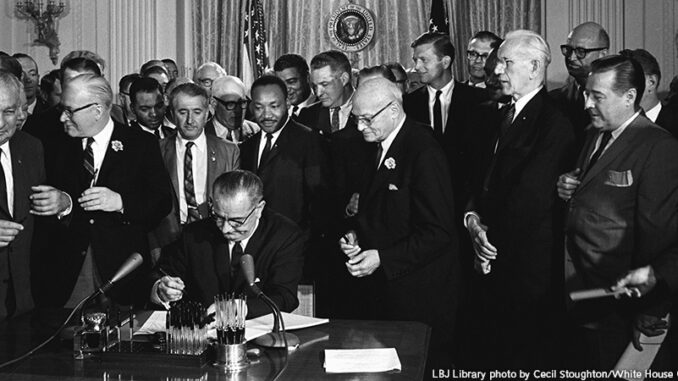
Last summer btw reported on the 50th anniversary of the historic March on Washington where Martin Luther King, Jr. inspired the masses to make the world a better place for all of its citizens. That gathering was considered one of the milestones that took place between 1955 and 1964 that culminated in landmark federal legislation to ensure protected equal rights under the law.
The “100 Year-Old Stain”

Following the Civil War, Congress passed the Thirteenth and Fourteenth Amendment to the U.S. Constitution, which gave African Americans equal protection under the law. However, shortly thereafter new laws arose (known as “Jim Crow” named for a minstrel show character) which allowed for “separate but equal” public facilities such a schools, rest rooms, water fountains, hotels, swimming pools. The problem was that the conditions of the facilities were far from equal. A movement to end racial segregation began in the mid 1950s and gained significant momentum throughout the 1960s through political and social activism.
The Legislation
In the summer of 1963, there were a number of significant civil rights protests across the United States that had turned ugly. The Birmingham Campaign, in particular, ended with officials turning high-powered fire hoses on high school students engaged in a peaceful protest. The incident was effective in drawing the world’s attention to the appalling state of race relations, particularly in the southern states.
On June 11. 1963, President John F. Kennedy gave a radio address where he publicly asked Congress to respond to what he called a “moral crisis.” Kennedy called for legislation that would give all Americans the right to be served in public establishments. He also called for all public schools to be desegregated. After Kennedy was assassinated later that year, new president Lyndon Johnson was committed to fulfill Kennedy’s promise. The proposed law expanded the law to include “race, color and national origin” as well as sex and religion.
Unlikely Resistance and Support
At that time, the Democrats had a significant majority in both the Senate and the House of Representatives. However, the Democrats had found themselves greatly divided over the issue of Civil Rights. Those in favor were Northern Democrats, while the “Southern Block” went to great lengths to oppose the bill when it went to Congress for a vote. At the same time, the Republican Party still saw itself as “the party of Abraham Lincoln” and was committed to the ideals the great president had fought for. In order to stall the proceedings, Republican Strom Thurman engaged in a filibuster, a tactic where a Senator refuses to yield the floor during debate (the House has time limits). Ultimately, however, the bill passed with a Senate vote of 73-27.
Impact
Many consider Civil Rights the single most controversial domestic issue of our time. It became a major campaign debate in the presidential election that took place just months after the passage of the Civil Rights Act of 1964. It paved the way for other legislation, including major reforms in voting passed the following year. Future civil rights legislation, including the Americans with Disabilities Act of 1990 and state-wide Marriage Equality bills also have a connection to the 1964 law.
The current residents in the White House did not let this day go by without commemoration. President Obama released a statement noting the importance of this anniversary. Vice President Biden also reflected on the efforts of civil rights activists that worked alongside Dr. King and others to get this legislation passed in 1964. On the White House blog, the vice president provided a brief sound recording of his time with some of these activists at another civil rights anniversary commemorated in 2013.
